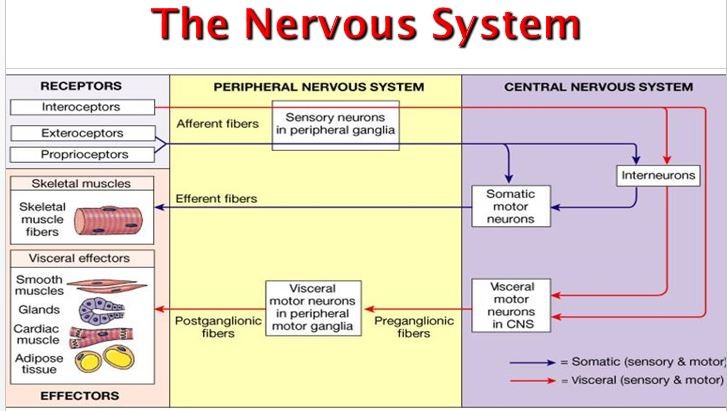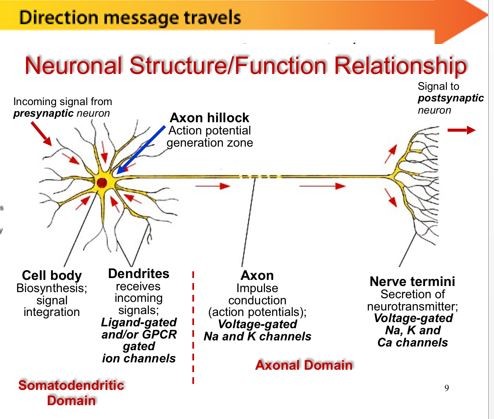-
Nervous system 3 function
-coordinates muscle movement/contraction using electrochemical signals
-sense internal & external environment
-integrates senses to form emotions and sensation
-
How nervous system works

Receptors receive stimuli sent to by afferent fibers (peripheral) sent to central nervous system then to muscles and glands
-
Peripheral nervous system PNS consist of? divided into?
nerves and ganalion cells outside brain or spinal cord
-sensory and motor division (motor and glands)
-
What is the longest nerve in body?
Sciatic Nerve
-
What are nerves?
Neurons bundle that transmit info to brain/spinal cord and into to muscle and organs
-
Central nervous system CNS composed of? do?
-consist of brain and spinal cord
-Control center of body
-relay message, process and analyze info
sensory info, generate thought, store memory
-
3 types of neuron
sensory neuron (PNS)
Interneurons (CNS)
Motor neurons (PNS)
-
Sensory neurons do and different kind of receptors
Convert external stimuli to spinal cord and brain
Mechanoreceptor- touch, pressure,
Thermoreceptors- temp
Photoreceptor- light
Chemorecptors- chemicals, oxygen, acidic
Nociceptor- pain
Osmoreceptor- concentration of solutes
-
Interneurons
-relay neurons only in CNS
-form circuits to communicate with each other
-connect sensory and motor neurons and carry impulses between them
-
Motor neurons

-In CNS but project axons outside CNS to control muscle
-release neurotransmitters that bind to post synaptic receptors
-Carry impulses from brain/spinal cord to muscle and gland
-
How neurons relay info ?
Info relayed from neuron to neuron using elecrticity and chemical messengers
-
What are Glia cell or neuroglia?
supportive cell in CNS and PNS
smaller and more # than neuron capable of mitosis
-protect and nourish neurons
-brain tumors more likely from this
-
Satellite cell
-PNS
-surround neuron cell bodies in ganglia
- prevent injury Regulate O2, CO2, nutrient, and neurotransmitter around neuron in ganglia
-
Schwann cell
-surround axon in PNS,
-myelination of peripheral axon
-repair process after injury
-
Oligodendrocytes
-Myelinate CNS axons
-provide structural framework
-
Astrocytes
CNS
-maintain BBB,
-barrier, prevent injury
- regulate ion, nutrient and dissolved gas concentrations,
-absorb and recycle neurotransmitters
-form scar tissue after injury
-
Microglia
CNS
Immunity
Macrophage: remove cell debris, waste and pathogen by phagocytosis
-
Ependymal cell
in CNS
- line ventricles(brain) and central canal (spinal cord). Assist in producing circulating and monitoring of cerebrospinal fluid (CSF)
-
Neurons have resting potential of ___ due to electrical gradient. What ion is inside/outside
-70 mV
Outside: Na+, Cl-, Ca +
Inside: K+, porteins
difference of cation and anion
-
Neuron function and structure
excitable cell that conduct info from one part to another via electrical impulse(action potential) conducted along lymph of axon
Cell body (soma)- nucleus and cytoplasm
Dendrites- extensions of PM from cell body, carry impulses from environment or other neuron toward cell body
Axon- carry Infor away from cell body, end at axon terminal
injunction between 2 nerve cell with gap where impulse pass through diffusion
Axon hillock- sum of total signal
synaptic terminal- area where electrical signal is converted to chemical signal
-
When does neuron travel electrically and when does it travel chemically
Within
Between
-
Communication between neurons
chemical signals
-chemical synapses release neurotransmitters that work through "lock and key"
-
How is signal relayed from one neuron to another?
synapse
-Axon terminal, synaptic cleft, dendrite
-
Process of neurotransmitter release
-Action potential depolarizes the axon terminal
- voltage gated Ca2+ channels
-release synaptic vesicle
-Neurotransmitter diffuse across synaptic cleft and bind with receptor on postsynaptic cell to cause response
-
Autonomic motor neuron synapse
-onto smooth muscle
release of neurotransmitter (not restricted to acetylcholine) from swelling fiber (varicosities)
-longer travel distance and can bind to any nearby smooth muscle cell unlike NMJ
-
Major neurotransmitters GABA, Acetylcholine, glutamate, norepinephrine,
Acetylcholine(excitatory). CNS and PNS
Norepinephrine, epinephrine, dopamine (excitatory). CNS and PNS (sympathetic)
Glutamate (excitatory): CNS Brain
GABA (inhibitory): CNS Brain and spinal cord
-
4 Nervous system ion channels
Ligand(chemically) gated- open by neurotransmitter
Mechanically gated- open by physical force
Always open- ex sodium and Potassium
Voltage gated- respond by changes in membrane potential
-
Neuronal structure/ function relationship

-
movement of ions within neuron create 2 types of electrical signals
Graded potential
-variable strength
-sum to cause an AP
Action potential
- all or none
-constant strength
generated at axon hillock
-
Graded potential
stops at axon hillock
Above -55mV needed to pass trigger zone
short live changes in electrical membrane potential
-
Excitatory post synaptic potential vs Inhibitory
Excitatory post synaptic potential-presynaptic neuron release glutamate neurotransmitter. cause positive shift Na+ in electrical potential(depolarization)
Inhibitory post synaptic potential- release of GABA. cause negative shift Cl- (hyperpolarisation)
-
Action potential
brief change in voltage across membrane due to flow of ion
intensity of stimulus = # of neuron generate
strong stimulus (above 55mV)caused by depolarization
electrical signal pass trigger zone and axon hillock
-
How is action potential similar to toilet?
-action potential or impulse is sent
-refractory period to be refilled
-resting potential, Charged when water is in tank
-All or nothing, same intensity every time
-
Temporal summation
-same presynaptic neuron stimulates postsynaptic neuron multiple times to cause action potential
-
Spatial summation
Multiple presynaptic neuron stimulating 1 postsynaptic neuron causing action potential
-
Axon vs axon hillock
Axon- integration of synaptic signal at axon hillock
generate action potential, and downstream synapese
-Transmit signal actively (amplifies action potential along the way)
axon hillock- decide if action potential will be produced or not
-need to go above 55 mV to initiate action potential
-sodium and potassium channel, sodium potassium pump,
-
Action potential is the reversal ______ and restoration ______of the membrane potential as an impulse travels along it
depolarization
repolarization
-
4 steps of transmission of into within neuron
1- sodium potassium pump (Na+/K+) pump maintain resting potential. some K+ leak out of neuron, membrane potential -70mV
2-Voltage gated Na+ channel open and sodium enter through through diffusion. If threshold potential achieved, all Na+ channel open cause membrane to be positive (depolarisation)
3-Na+ channel close and voltage gated K+ channel open. K+ diffuse out of neuron. Membrane become negative (repolarisation)
4- Na+ (out) and K+ (in) need to be reset by Na+/K+ pump, returning to resting potential(refractory period) impulse can only travel 1 direction
-
Continuous conduction vs saltatory conduction
Continuous conduction
-Action potential travel entire unmyelinated axon at 1 m/s
-wait for ion and gate to move before voltage gated Na+ and K+ channel regenerates
Saltatory conduction
Action potential only propagated at nodes of Ranvier of myelinated axon at 100m/s
-Ap generated only in myelin sheath gap and jumps
-
Saltatory conduction
Axonial ion channels are import for initiation and propagation of action potential to release neuro transmitters
-when action potential is present at 1 node, Na+ ion cause displacement of K+ ion down axon (makes next node more positive and depolarizes)
-
Conduction in unmyelinated neurons
Conduction slows due to degenerated myelin sheath
-
Multiple sclerosis
disease of brain and spinal cord
Immune system attack myelin sheath
cause communication problem between brain and body
-nerve damage
-vision loss, pain fatigue
-
Action potential have the same _____
amplitude (all or nothing)
weak -70 mV RMP with same action potential
-
Strong stimulus has
high frequency of action potential generated
-
Sensory, integrative, and motor function
Sensory function- sense change in internal/external environment through sensory (afferent neurons). Info from receptors
Integrative- analyze sensory info, store, make decisions on behavior (association or interneurons)
Motor functions- respond to stimuli by initating action. Motor (efferent) neuron. Send into to effectors (muslces and gland)

